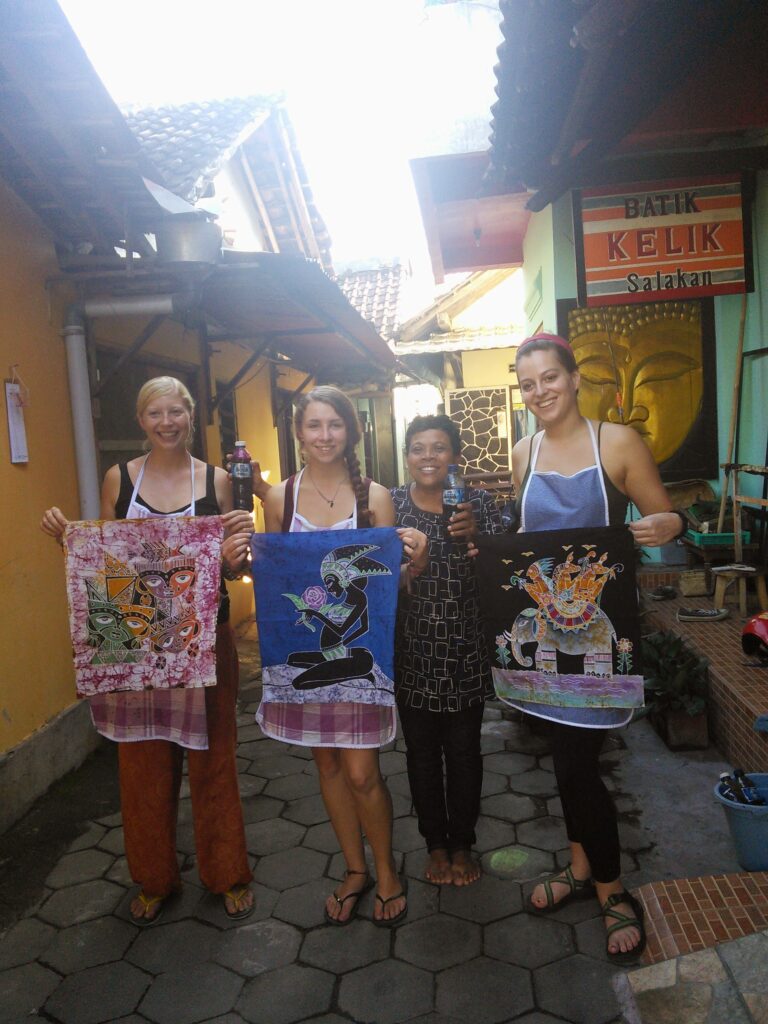Our first day in Yogyakarta (Jogja) was a write off, dedicated purely to easy living, sleep and food. The following day we set across town with an aim of seeing firstly the Kraton (the Sultan’s palace) and secondly, the market.
However, stopping to admire a sweet stall on route, we were approached by an Indonesian man named Joko and during conversation he shared about the city, found that we should not visit the Kraton with our shoulders bared. As we were both wearing strap tops we realised we needed a new plan for our day. It was then Joko told us of a Batik art exhibition a little off the general tourist track. The artwork sold and displayed here was created by students, teachers and masters of Jogja’s arts university. Someone at the exhibition would also show us the Batik process whilst we were there.
This sounded like a perfect substitute for our original plan, so we set off towards the exhibition. We were greeted at the door and led towards the back of the building where we were talked through the Batik process. Most artwork is done on cotton, sometimes silk. Wax is used to cover parts of the painting which have been finished with, to keep the colour intact, and paraffin is used to create a cracking, vein light effect in the paint. This is all done one layer at a time, with paintings taking weeks, or even months to complete.
We were so impressed by the artwork we both ended up leaving with two paintings! As they are made on cotton it is possible to fold them into tiny packages and carry them until I have a bedroom to hang them in.
We then retraced our steps back towards the market where we planned to wander through the many different areas Joko had described. This was easier said than done, all we could initially find was row after row and floor after floor of clothing and accessories. While we were trying to determine which direction we should head to next we were approached by another man, curious as to what at were doing. When he realised we were searching for the more interesting sections of the market he offered to show us the way.
This turned out to be one of the most selfless people I had met along my journey, spending the next few hours of his time taking us through the many hidden sections of the market (generally only seen by locals). He questioned our knowledge as we passed through herb, spice and vegetable stalls and filled in any gaps we had. We took a small break to try some traditional jasmine tea, which was served with a huge block of sugar.
As the afternoon drew on he then offered to take us out to the water castle (ruins which were once the baths for the Sultan) and an underground mosque, finally showing us a small workshop where puppets were made for the traditional puppet shows. He had given us so much of his free time we starting to wonder whether he was expecting to be paid, but when we parted ways he just shook our hands and went on his way!
That evening we went to see a puppet show. Flat puppets are held behind a white screen to create shadows for the audience to watch, and there is quite a large musical ensemble adding drama to the monologue. However, although it was wonderful to see a traditional part of their lives, I was unable to follow the story (told in Indonesian) and it became rather tiring towards the end of the 2 hours!
Yogyakarta is located near two sets of temple ruins, we visited one of these, Prembanan temples. The temples themselves were an impressive sight, but the atmosphere of the area had been ruined by the addition of green park fences and a children’s playground, features definitely not fitting with the initial design. This, along with the ridiculously high price tag of $20, left us feeling a little disappointed, and resulted in us deciding not to visit the other ruins (also priced over $20).

We visited the Kraton (the Sultan’s palace) the following day. This was a single storey building spread over quite a large area, and although there were some interesting features it was not nearly as impressive as the Sultan’s palace on Aladdin… We were very impressed with some traditional Java dancing we saw whilst visiting, the dancers mostly moved in a slow and deliberate manner. Difficult body positions would have to be sustained for a prolonged period, with limbs often suspended in the air. Not an easy task for sure!
On our final day we attended a Batik painting class. This gave us a much more comprehensive understanding of the process, as we were involved in each stage of development ourselves. Though a lot of help was provided from our teacher and her sons, we were in charge of the colour scheme and a large amount of the wax and paraffin application (creating the different colours and effects). Both Laura and I felt rather proud of our finished products, leaving the class with another addition to our new art collections.






More lovely people helping you – that’s realy nice :-). Pity about the overpriced ruins! The batik lesson looked really enjoyable – love your work of art! 🙂 Looking forward to the next instalment 🙂 xxx